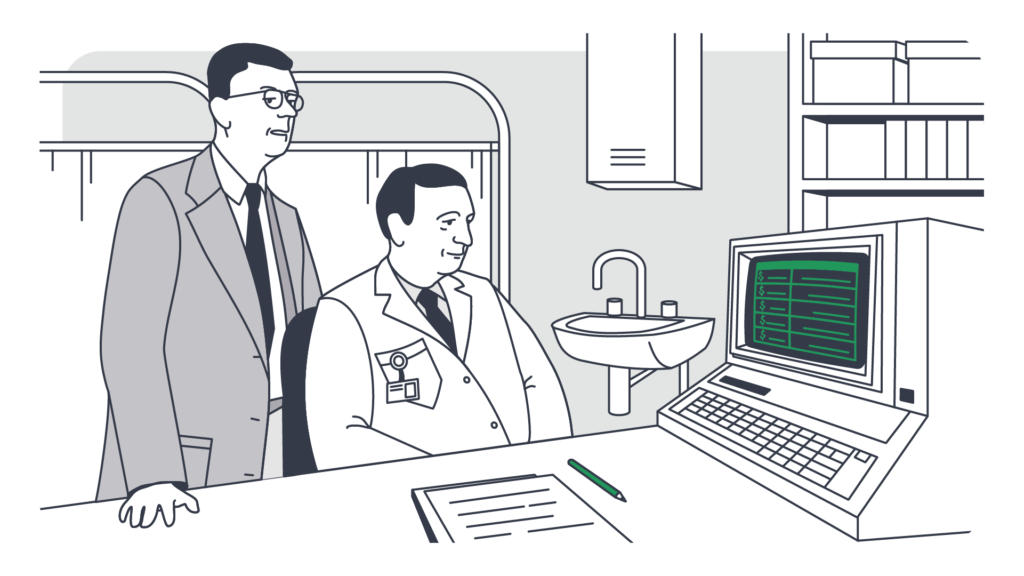A Conversation with Dr. Brent James

This is Part 2 of a 3 part series.
Recap: In Part 1 we met Edward Deming who helped post-World War II Japanese manufacturers compete with US companies by improving the quality of their goods. He argued that focusing on improving quality first and foremost not only increased sales by encouraging customer loyalty and positive word of mouth, but actually reduced costs by preventing recalls and longterm mistakes. Sony, Toyota and Ford were all companies that went on to dominate their markets by leveraging Deming’s principles. In Part 2, we see how these same lessons were leveraged at Intermountain Healthcare by Dr. Brent James who managed to simultaneously improve health outcomes and reduce hospital costs by simply focusing on quality improvement.
It was around the same time in the late 1980s that Edward Deming was helping turn Ford from a company haemorrhaging billions of dollars in losses to the most profitable automobile company in the US that Dr. Brent James was tasked to improve clinical outcomes at Intermountain Healthcare’s chain of hospitals.
Dr. James is a trained surgeon and Harvard economist. He has been named among Modern Healthcare’s ‘100 Most Powerful People in Healthcare’ and ‘25 Top Clinical Informaticists’. He holds faculty appointments at Stanford, Harvard, and the University of Sydney, and is a member of the National Academy of Science’s National Academy of Medicine and a Fellow of the American College of Physician Executives.
At the time, Dr. James was Chief Quality Officer and Executive Director at the Institute for Healthcare Leadership at Intermountain Healthcare.
John Wennberg, a leading healthcare industry researcher from The Dartmouth Institute said, “[Intermountain] is the best model in the country of how you can actually change healthcare.” And, Anthony Staines, a health scholar and hospital regulator from Switzerland who has studied some of the world’s most-admired hospitals, said, “Intermountain was really the only system where there was evidence of improvement in a majority of departments.”
But Intermountain wasn’t always this way. It was Dr. James who turned it all around.
An alarming discovery
In the late 1980s, Dr. James was working at Intermountain Healthcare when he met Intermountain’s Vice President for Finance, Steve Busboom.
Dr. James explains, “Steve Busboom had built the world’s first, what’s called an activity based costing system. What you do is, you identify every little thing that you can do to a patient during a care encounter. Everything. Steve’s cost-master had about 25,000 items in it. Any lab test, imaging exam, the dose of a drug. Anything from central supply, like a bedpan or a box of tissues, or an artificial hip joint. So, quite granular.
“And, then as you care for patients – anytime you give them something or do something, you do what’s called a transaction file. Steve had done it for financial purposes, but he argued that it could work in a clinical setting too.”
Around this same time, John Wennberg, who later founded the Dartmouth Atlas Project, had run a study that showed that variation in care delivered by health practitioners was so high, that it was a bigger determining factor of good health care outcomes than whether you had insurance. Dr. James shares,
“Wennberg showed that you can get radically different care for the same thing, dependent upon who you went to see. It was deeply professionally troubling because it implied we weren’t consistently able to deploy what worked.”
Hearing this, Steve Busboom, wanted to see if this same variation went on inside of a single clinic. He asked Dr. James, who was a Harvard trained statistician and had been internationally recognised for his work as a cancer surgeon, to do the research.
Dr. James shares, “I had pointed out to Steve that his data just wasn’t adequate. I said, patients aren’t the same. They have different severity percentage of symptoms for their primary disease. Even if I focused on one disease, one problem, the differences in that are huge.
“I insisted that we stage severity for every patient, that we individually identify and stage every comorbid disease, and that we identify in stages, every complication, and that we track long-term outcomes.”
To help, Steve gave Dr. James seven nurses and said he could train them up to go into the medical record and extract data using formal research.
“It turned out at the time to be about $US50,000 per study,” Dr. James says. “These days, that would be more like $US200,000 per study. And, frankly, if I hadn’t had the Vice President for Finance pushing hard, it never would have happened.”
Dr. James used the nurses to get the data he needed. He explains, “It turns out you could form a record of patients for common treatments that were identical coming in and identical going out. I believe it’s the best it’s ever been done. It’s what’s called an observational study.
“It’s not like running a trial. It’s not as rigorous. But, it’s the best you can do it. What we found was that the amount of variation [in care] in a single clinic or hospital is greater than the amount of geographic variation.
“So, we found this phenomenon, where from physician to physician, or even inside a single physician over time, this massive variation in the delivery of care. And, it was directly associated with worse clinical outcomes in some instances. And, it dramatically increased our costs.”
Dr. Brent James meets Edward Deming
What happened next was just another piece of luck. Dr. James was at a national meeting presenting his findings on variation in health care when he met Dr. Paul Batolda, a paediatrician from Minneapolis. Dr. Batolda said he knew a statistician who had encountered similar stuff in manufacturing and may be of help.
Dr. James explains, “So, he introduced me to Edward Deming. So, I’m one of the few people still alive you’ll meet who actually learned quality theory from Deming. I showed him my stuff and he said he had a theory that explained what we were seeing. And, more than that, it would allow us to make predictions about how you could make changes and see if they happened.”
Edward Deming told Dr. James he could help him analyse his studies and write a paper on his findings if his team could pull together all of the data.
Dr. James and his team identified almost 1,500 types of inpatient and outpatient care. They stacked them up in terms of how many patients were affected, the health risk to the patient, and internal variability.
In essence, what Dr. James and his team did was look at each diagnosis and treatment of a condition as a full process that was made up of lots of small parts. As opposed to seeing each of the steps involved in the treatment as its own process.
For instance, he didn’t say: the steps delivered by the doctors in the diagnosis phase is one process and the steps delivered by the nursing staff in the treatment phase is a different process. He looked at the treatment of a specific condition as one system.
This allowed him to pinpoint the exact conditions and treatment of these conditions that were having the worst clinical outcomes and costing the hospital the most. Dr. James explains,
“Out of those 1,500 types of inpatient and outpatient care documented at Intermountain’s hospitals, 104 of them – 7% of the processes – accounted for 95% of all of the care.”
“So, this wasn’t the 80/20 rule. This was a 95/7 rule,” Dr. James says.
Next, they did the same to all of the clinical services. “These are clinical processes that are not specific to a single condition,” Dr. James explains. “Pharmacy, imaging, lab, the therapy groups; respiratory therapy, occupational therapy, physical therapy. All nursing falls into this category. All patient safety.”
They assembled a similar list to document these processes and prioritised them. Then they started to pick off those processes that were having the biggest impact on the most people. And, they started to lay in formal processes using Edward Deming’s calculations.
Dr. James explains, “The first thing we studied was transurethral resection of the prostate (TURP). We showed a significant reduction in treatment failure rates. We were getting these things so you didn’t have to re-operate. Our costs fell by about 30%.”
In other words, by taking the time to iron out the TURP process of care so they could have better results the first time around, they reduced readmission rates, saving patients a lot of suffering and cutting hospital costs by hundreds of thousands of dollars.
Dr. James also found that by reducing infection rates from 1.8% to 0.4%, their costs decreased by $900,000 a year. Again, this was because complications and readmission rates were heavily reduced.
Dr. James and his team also tracked mortality rates. After improving the systems that were having the greatest impact on patient outcomes, Intermountain Healthcare was seeing 2,000 fewer deaths per year.
Over time, this improvement in processes managed to reduce Intermountains cost of operations by 13%. “It was associated with hundreds of millions of dollars in savings, by getting the care right,” Dr. James says.
Later, Dr. James documented all of his processes in a training course called the Intermountain Advanced Training Program (ATP) in Clinical Practice Improvement. To date, more than 5,000 senior physicians, nurses and administrative executives have taken the course, which is designed to help healthcare establishments emulate Intermountain’s results.
Want to learn the step-by-step process Dr. James used at Intermountain so you can try to replicate his results in your own clinic? Read his full strategy in Part 3: Dr. James’ 4 Step Strategy to Improve Health Outcomes, While Reducing Costs – A Moneyball Analogy.



